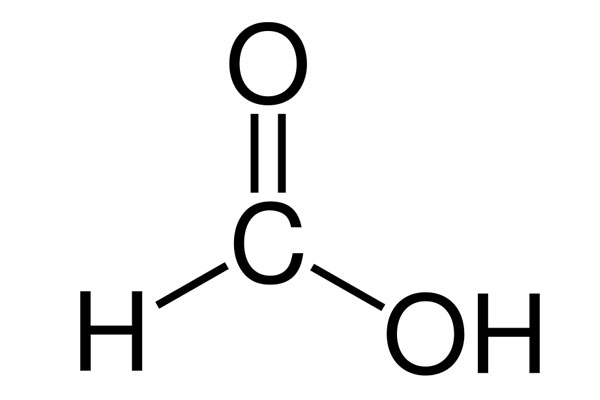Cas No: 64-18-6
EINESC No: 200-579-1
Molecular weight: 46,025 g/mol
Chemical Formula: CH2O2
Chemical Structure:
Physical Properties
General Properties: colorless, fuming liquid.
Odor: Strong, disturbing
Intensity: 1.220 g/cm3
Boiling point: 100.8 °C
Melting point: 8.4 °C
Flash point: 69 °C
Vapor pressure: 35 mmHg (25 °C)
Refraction index: 1.3714 (20 °C)
Solubility (aqueous) completely miscible

General Properties
Formic acid (methatonic acid), or also commonly known as ant acid, is the simplest corboxylic acid. It carries both aldehyde and carboxylic properties. Its name ‘formic’ refers to formika, Latin for ant, as it was first found in secration of ants. Ants use this acid as a defense mechanism towards its threats. Its chemically ten times stronger than acetic acid and it can easily go in a reaction to create ester via alcohol. It carries all properties of carboxylc acid. In presence of heat and acid, it disintigrates into carbon monoxde(CO) and water. For example, its reaction with suphuric acid is proper to use as a carbone dioxide source in labs. In presence of platin, it disintigrates into hydrogen(H2) and carbone dioxide(CO2)
Production
Although distillation was used to acquire it from ants, formic acid can be acquied from methanol now. Methanol and carbone monoxide are combined in presene of a strong alcali. This reaction, which is made with high pressure and in liquid phase, creates methyl format. Hydrolysis of mathyl format gives formic acid.
Besides these, there are many niche methods to acquire formic acid. Being a byproduct in manifacturing acetic acid, hydrogenizing carbone dioxide, bio-mass can be given as example. In 2020, an advaned photo-sheet technology was shown and it could convert carbone dioxide, water and oxygen into formic acid without anymore inputs.
Applications
Formic acid is fundamentally used as demulcent and anti-bacterial in live stock food. It is also used to extend shelf life in some food products. It is also used as coagulator in tanning of leather products, aftertreatment of textile products and rubber production.
Besides these, it is also used as missist in apiculture, anti-lime agent in some cleaning products, and wart medicines.
Safety Measures and Toxic Values
Formic acid has low toxicity, therefore, it is used in food products. Its LD50 value in rats is 1.8g/kg but, in its concentrated form, it is highly irritant for skin. There are some toxic consequences for being exposed to formic acid for long periods of time. Formic acid is the metabolite that causes blindness in methanol poisonings. Conducted researches also shown that it is mutagen. Chronic expose in humans may cause kidney diseases. There is also a high possibility that it may cause a chronic skin allergy.
Formic acid, while concentrated in a container, creates pressure by slowly disitigrating into carbone monoxide and water. Therefore it should be transferred or stored in plastic bottles with ventilated taps. It should be kept off from direct fire or high temperatures as it is a flammable chemical.